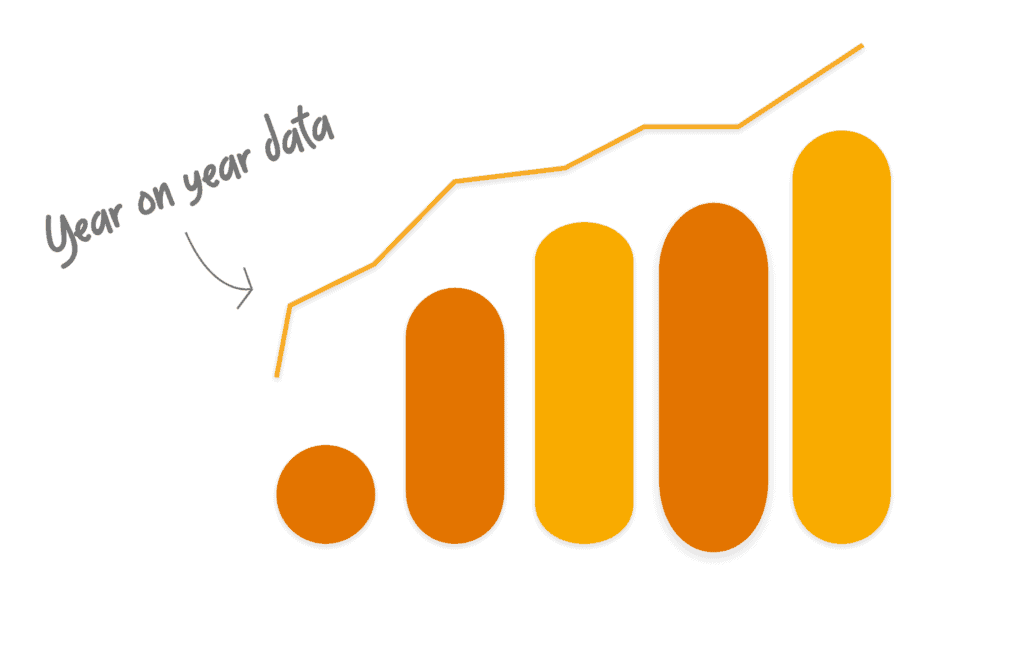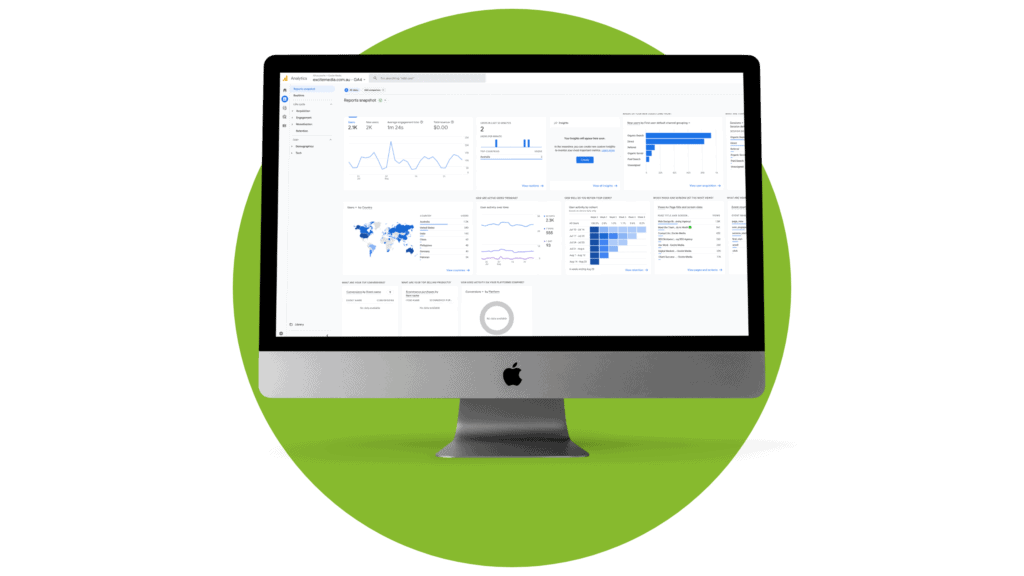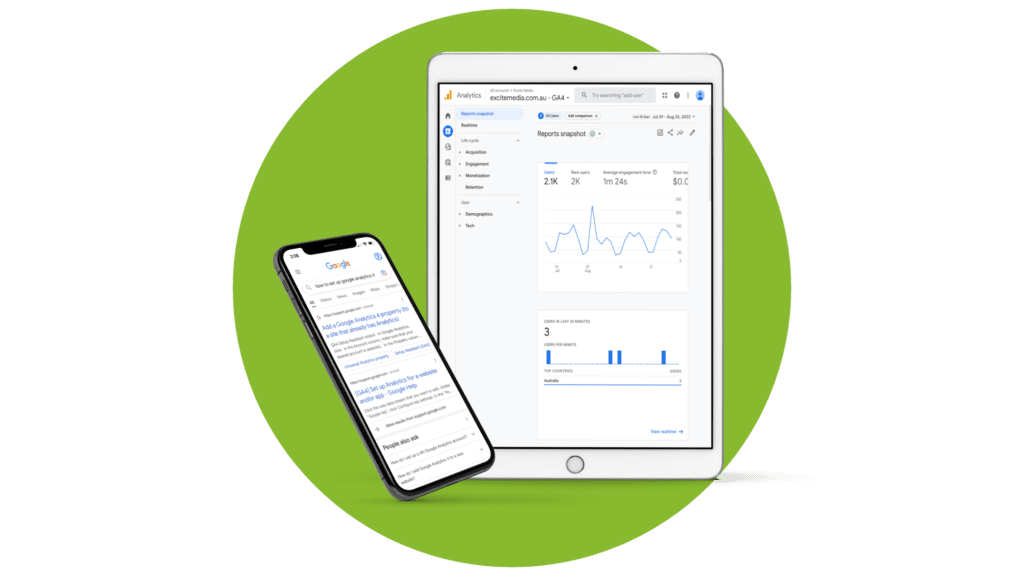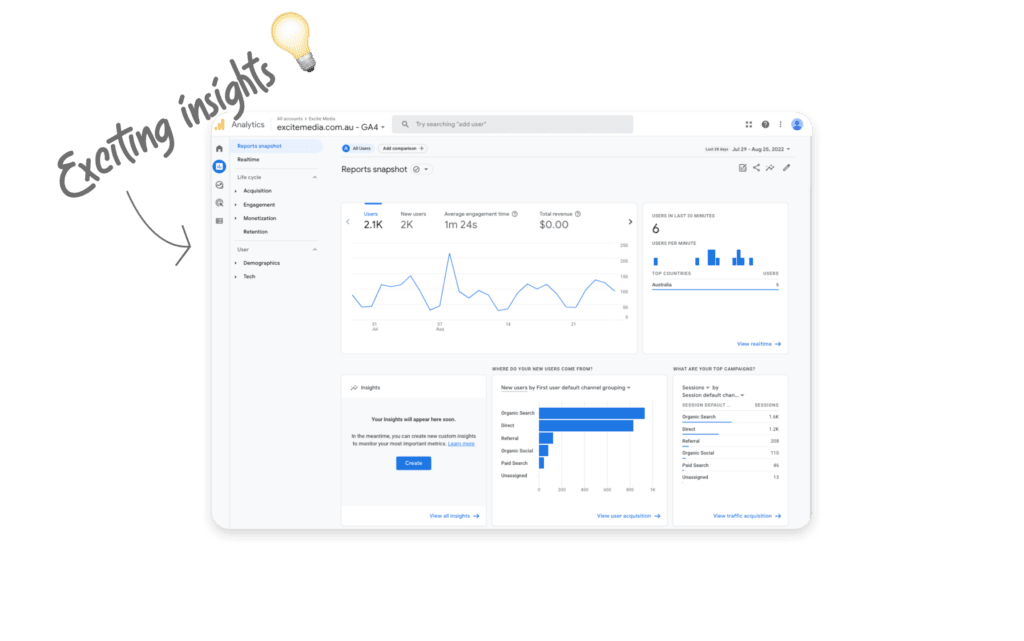If you own, manage or market a business with a website and are tracking your website metrics, you may have heard that Google released its ‘new’ analytics version GA4 a couple of years ago. But as you could continue using the trusty Universal Analytics, this was information that many chose to note and then pigeonhole for later.
But what you may not know (or have paused to consider properly) is that within the next 12 months, the ‘current’ (read: currently most used) version of Google Analytics — Universal Analytics (UA) — will stop tracking data completely from 1 July 2023. The data gathered up until that point will stay active for 6 months, and then it will be deleted. We repeat: deleted.
But don’t panic, dear reader. We’ve got you covered with all you need to know and do 👇
Table of Contents
ToggleWhat we'll cover 👇
- Reason 1: Year-on-Year Reporting
- Reason 2: Setting up advanced reporting features takes time
- Reason 3: Using GA4 in the day-to-day takes time to get used to
- Reason 4: You’ll want to allow time to iron out any problems
- Reason 5: There are some exciting insights you can benefit from right now
- Reason 6: This change is inevitable and being on the front foot is best

Universal Analytics will no longer track and record data as of 1 July 2023 🗓
Here’s why you’ll want to get started with GA4 now ⏰
Some of you may ask, ‘there’s plenty of time, why do I need to switch to GA4 now?’
The answer from our technical lead at Excite Media is that it’s important to, at the very least, install the GA4 tracking codes now.
Even if you want to continue using Universal Analytics alongside GA4 for a longer period.
In fact, here’s a top tip from our digital experts: we recommend running GA4 and Universal Analytics for now, until UA is phased out. The reasons for this will become apparent as you read through this guide.
Why do you want to get started with GA4 like, yesterday?

Reason 1: Year-on-Year Reporting ✅
Why year-on-year data is important 📈
Year-on-Year data is an invaluable reporting tool to not only see how your business is performing online, but also for strategy moving forward. YOY analysis gives you real insight into the monthly trends and fluctuations in interest, purchases and more over time, within an annual period. This allows you to plan ahead and use this information to inform your sales and marketing strategies.
For example, you might see, from year-on-year reporting, that the number of enquiries or sales via your website drops every June consistently every year, then gradually increases over July and then spikes up in August.
This information is invaluable. It can give you the missing puzzle piece that explains why your conversions are down during that month vs previous months — preventing you from incorrectly writing off a particular sales strategy, marketing campaign or social media effort as ineffective.
And it gives you the power to design marketing activities and campaigns that you can leverage to gain more interest and conversions in the months you traditionally see a drop in sales. A 25% off deal for the month of June could be the carrot that gets your consumers over the line in a time they traditionally wouldn’t be motivated to buy.
Year-on-Year data also gives you a solid basis for benchmarks. Want to increase your business performance over the year? Aim to beat last year’s monthly outcomes on a YOY monthly basis.
How year-on-year data is impacted by the phasing out of
Universal Analytics 👋
Universal Analytics will stop tracking as of 1 July 2023. This will force a move to GA4 for anyone that is still using UA at that point.
GA4’s metrics, reports and tracking are quite different to Universal Analytics (more on that later), but this means when looking at the data in the Google Analytics Universal Analytics version, versus that of the new GA4, we’re really not comparing apples to apples.
(Or, for a more relevant analogy, we’re not comparing cookies to cookies — see what we did there?) 🍪
Google Analytics 4 (GA4) has refined and redefined some of the core metrics that were a previous focus in Universal Analytics. Largely based on the number of website followers, and the ‘bounce rate’ of a certain page or the site overall, there were many factors that could skew this data or result in the wrong metrics being focused on.
We’ll delve deeper into this later. However, the point to note is that many of the metrics are different, and the count of these metrics is also not comparable when you look at UA vs GA4.
Therefore, we’re not able to get accurate data for Year on Year, when we use Universal Analytics to compare metrics up until the first of July 2023, and GA4 to compare metrics from that point onwards. For the best comparison, you’ll need to look within one platform. As Universal Analytics will not be available to do this moving forward, the answer for the best comparison lies in using GA4 for this YOY comparison.
Our recommendation is to get set up with GA4 now, start tracking everything you’ll want to track, and continue using both GA4 and UA side by side until you’re comfortable with GA4 and the updated reporting and visibility (or until you no longer can use UA — whichever comes first).
Preserving your Year-on-Year data is easy —at
least for the base metrics
As our technical lead and reporting gurus say, the most important thing to act on right away is to get that tracking in GA4 happening.
Let’s face it — GA4 is a fair bit more complicated to do the advanced reporting. We can handle that for you. But what is important — and relatively easy — is getting the base tracking for GA4 set up, so you can gather that year on year data, at least for the base metrics. We can handle that for you too. 😊
It’s as simple as getting your GA4 tracking set up. You can leave your Universal Analytics code and tracking in your website. But simply adding the GA4 tracking and getting it set up will give you a lot of insight in the future when GA4 is the only option. Because when that enforced switch happens, this way you’ll have some ‘historical data’ in the new platform.
Getting your more advanced tracking set up
Of course, it’s better if you can get everything you’d like to track set up to start gathering data in GA4 now — including conversions, engagement metrics, user flow paths, conversion paths and more. Because, like with the base metrics, the earlier you set this up, the less loss of data you’ll have when you need to make the switch.
These additional metrics will take extra time and expertise to set up as more technical knowledge is required to define, track, set up and start reporting for the more advanced metrics. This is something we can help you out with at Excite Media.
But again, the thing you can do now, relatively easily and quickly is to set up your base GA4 tracking to get started with the basics, at the very least.
The time to act is now — to reduce the lost data year on year ⏳
As the first of July 2022 has already passed, this means that for those who are not yet tracking data with GA4, there will already be missing year-on-year data when the time comes to make the enforced switch from 1st July 2023.
This means that for every day, week or month that passes, you’re losing comparative year-on-year data in the apples-to-apples comparison within GA4 year on year. Yikes.
If you’re not yet tracking in GA4, here is our recommended course of action:
- Set up, or get help setting up, GA4 in its base form
- Get some help with setting up the other important metrics for you to track — engagement, conversions and more. If you need help in defining what these should be, our experts can assist with that.
- If it’s important to you, save your historical Universal Analytics data before it is deleted. You could export all of the reports you’d like to keep now, and then schedule a reminder to do so again just before the data is deleted. That way, you won’t miss the memo when it’s about to be removed from the internet completely. (Or if you still do, at least you won’t lose everything).
Once those are all tracking in GA4, you’ve protected your future YOY data. Along with as much of your ‘year to date’, ‘quarter to date’ and ‘month to date’ data that you can at this point. These are the most important factors to ensure from a data preservation standpoint.

Reason 2: Setting up advanced reporting features takes time 📈
Reason 3: Using GA4 in the day-to-day takes time to get used to

Reason 4: You’ll want to allow time to iron out any problems 👖

Reason 5: There are some exciting insights you can benefit from right now 🤓
GA4 was created for a reason. It’s a new and improved Google Analytics and it gives you better insight into the factors which influence the money your website makes you. It sounds like a no-brainer, right? There are many exciting insights you can benefit from with GA4, and the sooner you get started, the sooner you can start seeing those insights and applying them.
The exciting new potential of GA4
For example, we’ve already mentioned about GA4 tracking how far someone scrolls down a page, but another exciting feature is that GA4 also tracks time on site, something that UA could never do. While UA only tracked “bounces” and half-hour sessions, GA4 tracks every second someone is on one of your web pages.
For more detail on what’s new in GA4, check out this guide on Google Analytics UA Vs GA4.
Reason 6: This change is inevitable and being on the front foot is best 💃


Excite Media Clients and GA4 🤝
If you’ve started a new website project with us within the past few months, or you’re one of our active digital marketing clients, then congratulations — you’re already set up with GA4 🎉
We’ve been installing GA4 tracking for any new project for some time now, to get that data collecting for you, for when it’s time to move over to GA4. For our active Digital Marketing clients, we’ve also been going through the process of determining the metrics that are important to you, and figuring out the technical side of tracking that, and doing so in the most effective and accurate way possible.
GA4 Reporting and Excite Media Clients
While GA4 metrics and reporting can be a little hard to decipher, we make this simpler for our clients. At Excite Media, we use third-party reporting to bring the raw data from your Google Analytics 4 account and turn it into simple and visual reporting that gives your clarity and insight into your performance. While GA4 is being tweaked by Google to be more user-friendly and understandable to the user that’s not as tech-savvy in the behind-the-scenes, these reports are the way to go for the interim.
Still have questions on GA4?
If you’d like to know where your GA4 is at, or have any questions, please don’t hesitate to reach out to your Excite Media Account Manager, or give our team a call. We’d be more than happy to talk you through your specific website, goals, metrics and how to ensure your tracking is set up for your success — from July 1 2023 and onwards.




